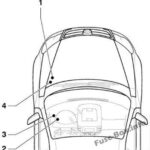The E85 chassis, encompassing models like the Z4, often becomes a canvas for performance enthusiasts. One common area of modification is the exhaust system. This article delves into the intricacies of exhaust upgrades, addressing common misconceptions and highlighting key considerations for optimizing performance without sacrificing drivability.
Exhaust System Fundamentals and the E85Z4
A well-designed exhaust system is crucial for efficient engine operation. It facilitates the expulsion of combustion byproducts and impacts engine breathing, directly influencing power output and torque delivery. While larger diameter piping is often associated with increased performance, simply increasing pipe size without considering other factors can lead to undesirable outcomes, particularly in the E85z4.
The “Y” Merge: Placement and Performance Implications
The location of the “Y” merge, where the individual exhaust pipes from each cylinder bank converge into a single pipe, plays a significant role in exhaust scavenging and backpressure. Positioning the “Y” merge too close to the exhaust manifold, as seen in some aftermarket systems, can negatively impact low-end torque. This is due to reduced exhaust velocity at lower RPMs, hindering efficient scavenging of exhaust gases. Conversely, a properly placed “Y” merge, further downstream from the manifold, allows for optimal exhaust flow across a wider RPM range, maintaining low-end torque while maximizing high-RPM power.
Exhaust Diameter: Dispelling the “Bigger is Better” Myth
While larger exhaust diameters can support increased flow at higher engine speeds, exceeding the optimal size can be detrimental. Contrary to popular belief, there’s no inherent benefit to using excessively large piping. Beyond a certain point, determined by engine displacement and tuning, further increases in diameter won’t yield additional power gains and can actually decrease performance due to reduced exhaust velocity and scavenging efficiency. For the E85Z4, careful consideration of exhaust diameter is essential to strike a balance between high-RPM power and low-end torque. A 2.5″ diameter, as chosen by the original poster in the referenced forum post, often represents a suitable compromise for street applications, maintaining backpressure while allowing for increased flow compared to the stock system.
Backpressure: Finding the Right Balance
Backpressure, the resistance to exhaust flow, is often misunderstood. While some backpressure is necessary for proper engine operation, particularly at lower RPMs, excessive backpressure hinders performance. The goal is to minimize backpressure while maintaining sufficient velocity for efficient scavenging. Choosing the appropriate exhaust diameter and “Y” merge location are critical factors in achieving this balance. Adding flanges before the resonator, as suggested by the original poster, allows for future modifications and potential customization of the exhaust sound and backpressure.
Conclusion: A Holistic Approach to E85Z4 Exhaust Modification
Modifying the exhaust system of an E85Z4 requires a comprehensive understanding of the interplay between various components and their impact on performance. Simply opting for the largest possible piping or arbitrarily positioning the “Y” merge can lead to suboptimal results. A well-engineered exhaust system considers factors such as engine displacement, intended use (street or track), and desired power delivery characteristics. Careful selection of components and proper installation are essential to maximizing performance gains without sacrificing drivability.


